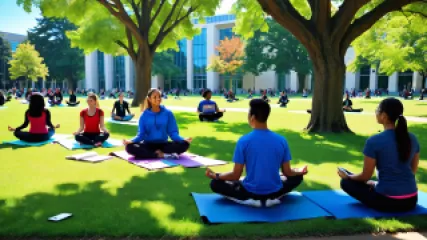10 Best Strategies for Managing Academic Pressure and Mental Health
Academic pressure and mental health are deeply intertwined, affecting students of all ages and academic levels. The intense demands of school or university can lead to stress, anxiety, and even depression. Addressing these issues requires a comprehensive approach that encompasses various strategies for managing stress and maintaining mental well-being.
In this article, we will explore the 10 best strategies for managing academic pressure and mental health. These strategies aim to provide relief from academic stress, offer support through academic stress support groups, and highlight the benefits of academic stress coaching services. By incorporating these practices into your daily routine, you can better navigate the challenges of academic life and maintain a healthy balance between your studies and personal well-being.
1. Time Management Techniques
One of the most effective ways to manage academic pressure is through proper time management. By organizing your schedule and prioritizing tasks, you can reduce stress and improve productivity. Here are some key time management techniques:
- Create a Study Schedule: Plan your study sessions in advance, allocating specific time slots for each subject. This helps ensure that you cover all necessary material without last-minute cramming.
- Set Realistic Goals: Break down larger tasks into smaller, manageable goals. This makes it easier to track progress and stay motivated.
- Use a Planner: Keep a planner or digital calendar to track assignments, deadlines, and important dates. This helps prevent procrastination and ensures you stay on top of your responsibilities.
- Limit Distractions: Identify and eliminate distractions during study sessions. This may involve turning off notifications, finding a quiet study space, or using apps that block social media.
- Take Regular Breaks: Incorporate short breaks into your study schedule to rest and recharge. Techniques like the Pomodoro Technique, which involves studying for 25 minutes followed by a 5-minute break, can be particularly effective.
2. Mindfulness and Meditation Practices
Mindfulness and meditation are powerful tools for managing academic stress and improving mental health. These practices help calm the mind, increase focus, and promote a sense of inner peace. Here are some mindfulness and meditation techniques to consider:
- Breathing Exercises: Practice deep breathing exercises to reduce stress and anxiety. Focus on your breath, inhaling deeply through your nose and exhaling slowly through your mouth.
- Mindful Meditation: Set aside time each day for mindful meditation. Find a quiet space, sit comfortably, and focus on your breath or a specific mantra. Allow thoughts to come and go without judgment.
- Body Scan Meditation: Perform a body scan meditation by mentally scanning your body from head to toe, noticing any areas of tension or discomfort. This helps release physical stress and promotes relaxation.
- Gratitude Journaling: Keep a gratitude journal to reflect on positive experiences and moments of joy. Writing down things you are grateful for can shift your focus away from stress and foster a positive mindset.
- Mindful Walking: Take mindful walks in nature, paying attention to your surroundings and the sensations in your body. This practice can help clear your mind and reduce stress.
3. Physical Activity and Exercise
Regular physical activity is essential for maintaining both physical and mental health. Exercise releases endorphins, which are natural mood boosters, and helps reduce stress and anxiety. Here are some ways to incorporate physical activity into your routine:
- Daily Exercise Routine: Aim for at least 30 minutes of moderate exercise each day. This could include activities like jogging, cycling, swimming, or practicing yoga.
- Join a Sports Team: Participating in team sports can provide a sense of community and support, while also offering a fun way to stay active.
- Try Different Workouts: Experiment with different types of workouts to find what you enjoy most. This could include dance classes, martial arts, or group fitness sessions.
- Stay Active During Study Breaks: Use study breaks to stretch or engage in quick physical activities like jumping jacks or a short walk. This helps refresh your mind and body.
- Practice Yoga and Stretching: Incorporate yoga and stretching exercises into your routine to improve flexibility, reduce muscle tension, and promote relaxation.
4. Healthy Eating Habits
Nutrition plays a crucial role in maintaining mental health and managing academic pressure. A balanced diet provides the necessary nutrients for brain function and overall well-being. Here are some tips for healthy eating habits:
- Eat Balanced Meals: Ensure your meals include a variety of nutrients, such as proteins, healthy fats, carbohydrates, vitamins, and minerals. This supports cognitive function and energy levels.
- Stay Hydrated: Drink plenty of water throughout the day to stay hydrated. Dehydration can affect concentration and cognitive performance.
- Limit Caffeine and Sugar: Avoid excessive consumption of caffeine and sugary snacks, as they can lead to energy crashes and increased anxiety.
- Include Brain-Boosting Foods: Incorporate foods rich in omega-3 fatty acids (e.g., fish, walnuts), antioxidants (e.g., berries, dark chocolate), and vitamins (e.g., leafy greens, eggs) to support brain health.
- Plan and Prep Meals: Plan your meals ahead of time and prepare healthy snacks to avoid relying on fast food or unhealthy options during busy study periods.
5. Seeking Academic Stress Support Groups
Joining an academic stress support group can provide valuable emotional support and practical advice for managing academic pressure. These groups offer a safe space to share experiences, learn coping strategies, and connect with others facing similar challenges. Here are some benefits of participating in support groups:
- Shared Experiences: Hearing from others who are going through similar struggles can help you feel less alone and more understood.
- Emotional Support: Support groups provide a platform to express your feelings and receive encouragement from peers and facilitators.
- Coping Strategies: Learn new coping mechanisms and stress-relief techniques from group discussions and guest speakers.
- Accountability: Being part of a group can motivate you to stay committed to your goals and implement positive changes in your life.
- Networking Opportunities: Build connections with fellow students and potentially form study groups or friendships outside of the support group.
6. Academic Stress Coaching Services
Professional academic stress coaching services offer personalized guidance and support to help students manage academic pressure and improve mental health. Coaches work with students to develop effective study habits, time management skills, and stress-relief techniques. Here are some advantages of seeking academic stress coaching:
- Personalized Guidance: Coaches provide tailored advice and strategies based on your specific needs and challenges.
- Goal Setting: Work with a coach to set realistic academic and personal goals, and create a plan to achieve them.
- Accountability: Regular check-ins with a coach help keep you accountable and on track with your goals.
- Stress Management Techniques: Learn effective methods for managing stress, such as mindfulness practices, relaxation techniques, and healthy lifestyle choices.
- Improved Performance: With the support of a coach, you can enhance your academic performance and overall well-being.
7. Building a Strong Support System
Having a reliable support system is crucial for managing academic pressure and maintaining mental health. This includes family, friends, mentors, and academic advisors who can offer guidance, encouragement, and assistance. Here are some steps to build a strong support system:
- Communicate with Family: Keep open lines of communication with your family members. Share your academic challenges and successes, and seek their advice and support.
- Connect with Friends: Surround yourself with friends who understand your academic pressures and can provide emotional support. Study together, share resources, and encourage each other.
- Seek Mentorship: Find a mentor, such as a professor, advisor, or older student, who can offer guidance and insight based on their experiences.
- Utilize Campus Resources: Take advantage of campus resources, such as counseling services, academic advisors, and peer tutoring programs. These services are designed to support your academic and mental well-being.
- Join Student Organizations: Participate in clubs or student organizations related to your interests. This can help you build connections, develop new skills, and find a sense of belonging.
8. Practicing Self-Care
Self-care is essential for maintaining mental health and managing academic pressure. It involves taking deliberate actions to care for your physical, emotional, and mental well-being. Here are some self-care practices to incorporate into your routine:
- Prioritize Sleep: Ensure you get enough sleep each night. Aim for 7-9 hours of quality sleep to support cognitive function and overall health.
- Engage in Hobbies: Make time for activities you enjoy, whether it's reading, painting, playing a musical instrument, or spending time in nature.
- Practice Relaxation Techniques: Incorporate relaxation techniques, such as deep breathing, progressive muscle relaxation, or aromatherapy, into your daily routine.
- Set Boundaries: Establish healthy boundaries to protect your time and energy. Learn to say no when necessary and prioritize self-care over excessive commitments.
- Seek Professional Help: If you're struggling with your mental health, don't hesitate to seek professional help from a therapist or counselor. They can provide valuable support and guidance.
9. Developing Resilience and Coping Skills
Resilience and effective coping skills are vital for navigating academic pressure and maintaining mental health. Resilience allows you to bounce back from setbacks, while coping skills help you manage stress and challenges effectively. Here are some ways to develop resilience and coping skills:
- Focus on Strengths: Identify and build on your strengths and achievements. This boosts self-confidence and helps you approach challenges with a positive attitude.
- Embrace Change: View change as an opportunity for growth and learning. Adaptability is a key component of resilience.
- Practice Positive Thinking: Cultivate a positive mindset by challenging negative thoughts and focusing on optimistic perspectives.
- Develop Problem-Solving Skills: Enhance your problem-solving abilities by breaking down complex issues into smaller, manageable steps. Seek solutions rather than dwelling on problems.
- Build Emotional Awareness: Increase your emotional awareness by recognizing and understanding your emotions. This helps you respond to stress in healthier ways.
10. Creating a Balanced Lifestyle
A balanced lifestyle is essential for managing academic pressure and maintaining mental health. This involves finding harmony between your academic responsibilities and personal life. Here are some tips for creating a balanced lifestyle:
- Set Priorities: Determine your priorities and allocate time accordingly. Balance academic tasks with personal activities, social interactions, and self-care.
- Establish Routines: Create daily and weekly routines that incorporate time for studying, exercising, relaxing, and socializing. Consistency helps reduce stress and improve productivity.
- Find Joy in Small Moments: Appreciate and savor small moments of joy and relaxation throughout your day. This can help maintain a positive outlook and reduce feelings of overwhelm.
- Limit Overcommitment: Avoid overcommitting to extracurricular activities or obligations. Focus on quality over quantity and ensure you have time to rest and recharge.
- Seek Balance in All Areas: Strive for balance in all aspects of your life, including academics, physical health, mental well-being, social connections, and personal growth.
Conclusion: Embracing a Holistic Approach
Managing academic pressure and maintaining mental health require a holistic approach that encompasses various strategies and practices. By implementing the 10 strategies outlined in this article, you can effectively navigate the challenges of academic life and foster a healthy balance between your studies and personal well-being.
Remember that it is essential to seek support when needed, whether through academic stress support groups, academic stress coaching services, or your personal support system. Prioritizing self-care, building resilience, and creating a balanced lifestyle are key to thriving academically and maintaining mental health.
Ultimately, embracing these strategies will not only help you manage academic pressure but also contribute to your overall growth and well-being. Take proactive steps to care for your mental health, and you will be better equipped to achieve your academic goals and lead a fulfilling life.






